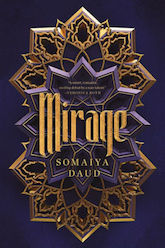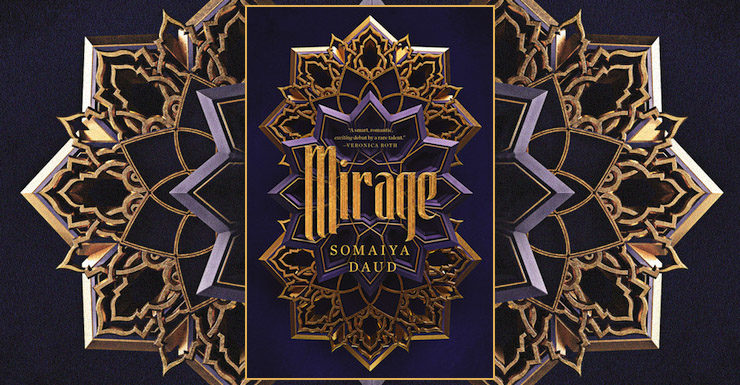Young adult fiction is glutted with stories of royal court intrigue, romance between nobles and commoners, and princesses vying for power. Few, however, are set in an interplanetary space opera. With Mirage, Somaiya Daud goes one step further and uses both backdrops to sneak in a take down of colonialism, and from the perspective of the colonized, no less.
When the Vathek invaded Amani’s homeworld, everything changed. For the better, the Vathek insisted as they remade a world into their image. For the worse, the people of Cadiz and Andala whispered quietly amongst themselves. Not for long, vowed the rebels hiding in the countryside.
Daud drops the reader into the story a few decades after King Mathis’ conquest. The war and subsequent purge are recent enough that many remember life before, but settled enough that the survivors are resigned to their fate. Teenage Amani has only ever know life under occupation, but in her small agricultural community, her cultural heritage has survived. The night she and several other girls receive their daan—tattoos denoting genealogy and familial aspirations—is meant to be a celebration. But instead she’s kidnapped by soldiers and whisked away to the palace. There, her daan is cut from her skin, her body beaten, and her spirit weakened as she is forced to become the body double of Princess Maram.
Over the course of the novel, Amani tries to use her position to influence Maram, to show her the errors of her father’s ways by connecting Maram to their shared heritage. Much to Maram and the other Vathek nobles’ chagrin, she is half Andalaan, a child born of a wartime concession by her mother as a means to peace. Maram wants nothing more than to be like her father and to be liked by her father, and if that means her mother’s people hate her, so be it. But that gets harder as Amani opens her eyes to new experiences and ideas. Further complicating matters is the handsome nobleman Idris, an Andalaan betrothed to Maram for political reasons but whose eyes keep wandering toward Amani.
The scaffolding of the plot is familiar to the point of predictable, but the sociocultural context Daud builds around it is riveting. Amani’s culture is directly inspired by the Amazigh people of North Africa, also known as Berbers, although many dislike that name. Although I never thought I would ever write about Madonna or the MTV VMAs in a YA SF book review, that’s exactly what I’m about to do. Setting aside Madonna’s HUUUUUUUUGELY problematic and self-centered tribute to Aretha Franklin, her attire is what’s particularly relevant here. Madonna festooned herself with a variety of clothing, accessories, and stylings mishmashed from across the Imazighen cultural map, and the internet is awash in think pieces and hot takes on cultural appropriation and Amazigh history. In other words, now’s a great time to get your googling on if you want to learn more about a people we don’t discuss much.
Daud is Moroccan Amazigh and she imbues her culture in her book. However, one of the most intriguing references is the name “Vathek.” Vathek, an Arabian Tale is an 18th century story written in French by the English novelist William Beckford. At the time, Europe was in the midst of a continental-wide freak out over “orientalism,” a trend in part kicked off by French author Antoine Galland’s pseudo-translation of Arabian Nights. Vathek is a western story about the evils of barbarism (where we get the word “Berber”) set in a western interpretation of a North African/Middle Eastern society and written by a western man who made money by exploiting a culture not his own. Not only did Daud write a story revealing colonialism for the horror show it really is, but she then named the conquering emperor after a literary version of colonialism. I mean wow. It takes guts to cut that deep, but Daud did it without even flinching. Girl. Yes.
Of course, my second favorite sneaky reference is the two hundred thousand year old library and archives destroyed by the Vathekaar—I am a librarian after all. The fictional library of El Maktabatil Fihri seems to be a combination of the Iraqi National Library and Archives, once known as al-Maktabatil Aammah, and Fatima Al-Fihri, an educated Muslim woman from about 800 ADE who founded a madrasa and mosque now known as the University of Al Quaraouiyine. It the oldest continuously operating university in the world. The university’s library is also one of the oldest in the world.
Where Mirage falters is with everyone not Amani. Amani is the protagonist, but Maram’s development is so vital to the plot and to Amani’s own arc that she is almost a co-star. By the end we have a better understanding of why Maram behaves the way she does, but because the novel takes place entirely from Amani’s perspective we know nothing of how Maram feels underneath her public posturing. Maram’s dramatic personality shifts and personal growth hold a lot less weight when they rely not on her self-reflection but Amani’s opinions.
Buy the Book


Mirage
I also wish Daud had taken the time to have a conversation about slavery. Amani isn’t just kidnapped by Vathek royalty—she’s enslaved. She doesn’t sign a contract or agree to work for a set amount of time in exchange for her freedom. Her personal agency is literally, physically, and psychologically stripped from her, and she has no choice or say in what happens to her. Maram commands and Amani complies. Those in power have full and explicit control over her body, environment, actions, and future. Yet Daud never explores the larger context of that. Is Vathek enslavement of the people of Cadiz common? If so, then the reader needs to know all the ways the colonizers have devastated the indigenous population. If not, we need to see Amani react not just to the loss of her daan but the loss of her freedom as well. But instead of delving into that, Daud sidesteps it by having Amani try to befriend Maram.
Mirage is full of swoon-y, action-y, melodramatic-y goodness. Readers who love clever, independent young women, protagonists of color, cultures we don’t normally get to see positively represented in fiction, lite-SF, space opera, royal court intrigue, and delectable insta-love will inhale Mirage. I can already tell the teens who use my library will be clamoring for this book. And, for that matter, I’ll be recommending it heavily.
Mirage is available August 28th from Flatiron Books.
Listen to an interview with the author here.
Alex Brown is a YA librarian by day, local historian by night, pop culture critic/reviewer by passion, and an ace/aro Black woman all the time. Keep up with her every move on Twitter, check out her endless barrage of cute rat pics on Instagram, or follow along with her reading adventures on her blog.










